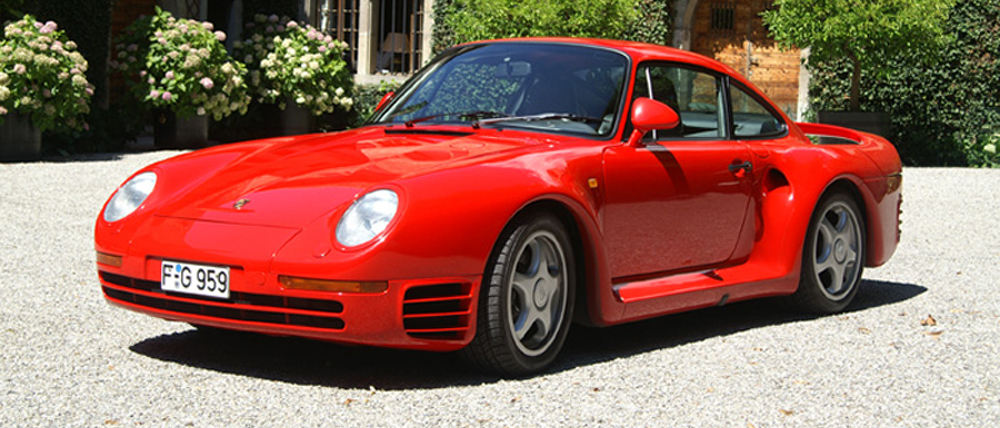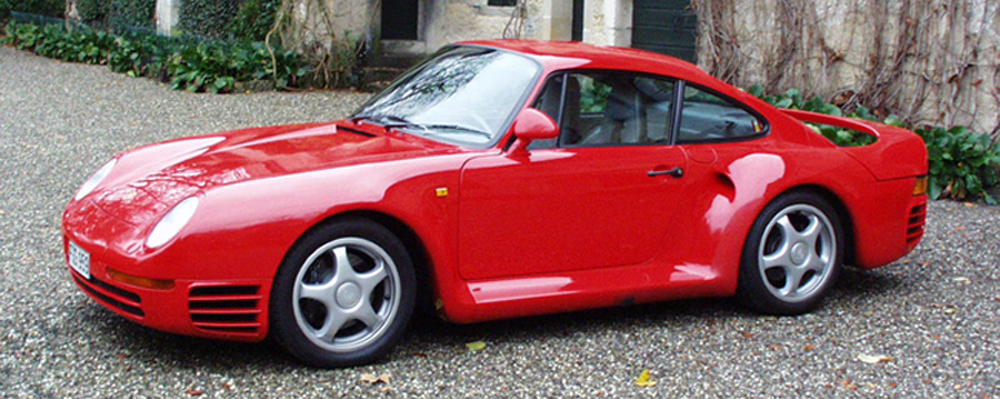|

1988 Porsche 959
- Power unit is a six-cylinder boxer engine with register turbocharger, Capacity of 2849 cc with Output of 450 bhp (331 kW).
- Top speed: 315 km/h (195 mph)
No other Porsche offers the same passionate symbiosis of competition and high technology as the 959. Originally conceived for the new Group B
racing category, the 959 was built in an exclusive series of just 292 units as a spearhead in technology based on the 911 model series. Subsequent
production models benefited significantly from this supersports car with its attractive looks. Despite its price tag of DM 420,000, the 959 was quickly sold out.
The "intense" idea: the Porsche 959 Coupé and motorsport
The Porsche 959 Coupé, a genuine dream and supersports car built in the '80s, impressively conveys the passion of Porsche's engineers. Conceived
originally as a Group B racing car for use in motorsport, the Porsche 959 stands in the new Porsche Museum for the "intense" idea so typical of motorsport with all its emotions.
Motorsport is indeed the starting point for Porsche in the development and improvement of production cars, but also stands for success, triumph and
emotion. The passion of the Company, its engineers, mechanics, drivers and aficionados the world over is indeed the essential factor and the fundamental difference borne out in more than 28,000 racing victories.
Since it is impossible to present the thrill of motorsport through technical exhibits alone, not only legendary racing cars, but also emotional symbols
such as the historical starter's flag for the 24 Hours of Le Mans and more than 150 coveted trophies offer the visitor a truly "intense" experience of this idea.
The Porsche 959 Story
Before the Ferrari F40, before the McLaren F1, almost before the term 'supercar' was invented, there was the Porsche 959, an expression of technical
competence, research, development and competitiveness that defined the genre and brought a new excitement to automotive development.
The Porsche 959's odyssey started in 1983 and involved many pioneering techniques including the moulded fiberglass/ Kevlar bodywork, the first
production use of duPont's Kevlar aramid material. The suspension had three ride-height selections in addition to three settings for the shocks. Its
antilock braking system was controlled by high speed microprocessors augmented by run-flat Bridgestone tyres. The 2,849cc Porsche twin sequential
turbocharged and intercooled flat six engine ran a maximum of 1 atmosphere boost and used water cooling for the six individual cylinder heads,
producing a totally reliable 450 horsepower at 6,500 rpm (easily boosted to 650bhp) driving through an electronically-controlled all wheel drive
system. Performance? 198+ mph top speed and 0-100km/h in a staggering 3.6 seconds...even in the wet. The list of the Porsche 959's achievements
could go on and on. It is sufficient to reiterate only that it was a tour de force in any number of areas and was the first of a new breed of ultra high performance supercar.
Just 292 Porsche 959s left the Stuttgart factory, all ordered long before production and each one of them destined for wealthy automotive
connoisseurs, but probably the buyer whose purchase attracted the most column inches was arguably the 20th century's most famous (and most
recorded) orchestra conductor, Austrian-born Herbert von Karajan. Born in 1908, the flamboyant von Karajan led the Berlin Philharmonic Orchestra for
no fewer than 35 years. It might come as little surprise, given his artistic success and origins, to learn that von Karajan was a motoring enthusiast and that his favoured marque, founded by a fellow Austrian, was Porsche.
Von Karajan had owned examples of several of the Stuttgart-based firm's top-of-the-range models, including a Carrera RS and one of the first 911
Turbos, usually built for him with bespoke features or perhaps in non-standard colour schemes. When Porsche decided to put the limited edition 959
supercar into production, one of the first clients they contacted was von Karajan. When ready, an early production, red 959 was despatched for the
maestro to try, and the test was filmed by national television: a DVD of the programme accompanies this car. Although already in his 80s, the
conductor put the supercar through its paces and was so impressed that he ordered one for himself, liveried in the same Guards Red but with special
dove grey cloth upholstery (triple colour leather was standard) to provide improved grip whilst cornering. In the television programme, von Karajan is
heard expressing wonderment about both the car's performance and price, prompting his wife to comment: "you'd better sell more records".
Somewhat appropriate given that critics charged von Karajan with initiating an inflational spiral in performance fees, not least of which his own…
The guarantee and service book for chassis '00216' shows that the car was delivered new on 15th February 1988 by the factory itself to von Karajan
at his winter residence in St Moritz. It remained in his hands until the year of his death, 1989, shortly before which he sold it to an old friend, a well
known philanthropist, socialite, sportsman and motoring enthusiast from whose family it is now offered for sale. The second owner was no stranger to
fast motor cars, having owned a specially ordered Ferrari 250MM and a new Mercedes-Benz 300SL Gullwing before he had even graduated from
Harvard. In his tenure the 959 has been maintained by a full time chauffeur in a climate controlled garage, with maintenance carried out scrupulously
as evidenced by records with the car. Even the brake discs would be cleaned before it was put away after each drive. In order to keep its German
'959' registration, the car has been registered in the name of a family friend in Frankfurt (the late owner was Swiss domiciled) and it has been
returned to either the factory or Porsche's main Frankfurt agent for major servicing. The last intervention took place in July 2006 at 35,470km; the total mileage covered today is 35,892km.
All the factory tools are present and unused in their cases in the luggage compartment, plus the jack, wheel wrench and hard bound spare parts
catalogue. Inside the burgundy leather '959' wallet, which still smells factory fresh, are two owners handbooks (German and French versions),
guarantee and service book (fully stamped), unopened Blaupunkt stereo instruction book, original Bridgestone RE71 (for 959s only) tyre service point
booklet, previous DEKRA roadworthiness certificates, and even the Porsche tag originally attached to 959 gear levers upon delivery to instruct their
new owners in the use of a sixth gear. One would be hard pressed to find an equally comprehensively documented or equipped 959.
The exterior paintwork is immaculate with no faults immediately visible, whilst the interior carpeting and seats are also unmarked. The road wheels are
free of kerb damage and the engine bay is almost spotless. Glass and rubber seals are all excellent. The engine starts immediately, idles well and
sounds superb. The car has not sat unused for long periods of time (never advisable for this high tech model) and has no known needs. It should not
be confused with many of the 959s which come to the market with gaps in their histories, incomplete service records or mummification from static storage.
We have no hesitation in assessing this as the best 959 we have handled and in recommending it to any collector of landmark sports cars as an
excellent long term investment. Nearly twenty years after it first appeared, the 959's performance is still breathtaking and this example's celebrity
provenance, immaculate condition and comprehensive documentation tick all the boxes for future collectability.

|

